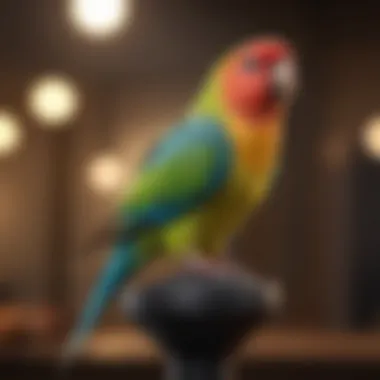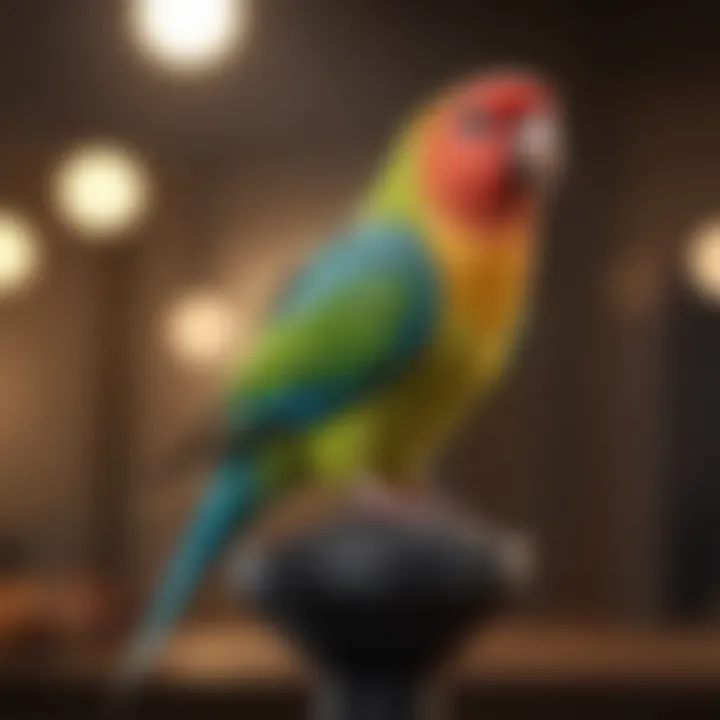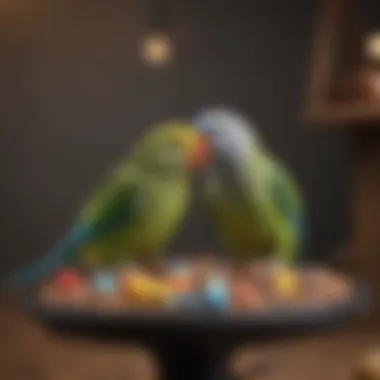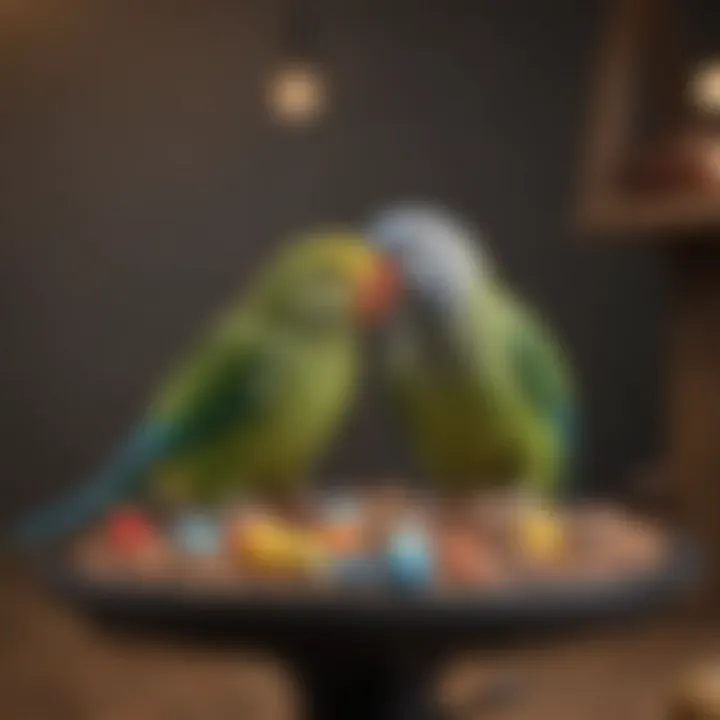Understanding the Significance of Parakeet Stands in Care


Intro
Parakeets bring a splash of color and joy into our homes, fluttering about with their cheerful tweets and vibrant feathers. Yet, adopting these lively companions encompasses much more than simply providing them with food and a cage. The decisions we make regarding their living environment—particularly the selection of parakeet stands—can significantly impact their overall well-being and happiness.
Understanding how to create a suitable habitat tailored specifically for your parakeet is an essential aspect of responsible pet ownership. This article will guide you through the intricacies of parakeet stands, detailing their various types, features, and maintenance. By devising an enriching environment, you can enhance the lives of these charming birds, allowing them to thrive and exhibit their natural behaviors.
Understanding Your Pet
Pet Behavior Basics
Knowing your parakeet's behavior is what lays the groundwork for their care. These birds are inherently social creatures that thrive on interaction, both with their human caretakers and with one another. They have unique vocalizations and body language, which can be baffling if you're unfamiliar with avian communication. For instance, when your parakeet puffs up its feathers and does a little dance, it often signifies happiness or excitement.
Setting up a parakeet stand allows these birds to engage in their natural tendencies to perch, preen, and play. Having designated spaces to explore can improve their mental health, keeping them happier and more active.
Common Breed Characteristics
Each breed of parakeet has its own set of characteristics. Budgerigars, for example, are the most common type and typically require a lot of social interaction and stimulation. They can live well over a decade with proper care. On the other hand, different breeds like Lovebirds exhibit slightly different social behaviors and can become very attached to their partners.
Species-Specific Needs
Understanding that not all parakeets are created equal is key. For instance, while some species are content with simple stands, others may benefit from more elaborate structures with multiple levels. Researching the specific needs of your bird is the wisest first step.
Pet Care and Maintenance
Feeding Guidelines
An integral part of keeping your parakeet healthy is their diet. A balanced mix of seeds, pellets, and fresh fruits and vegetables is ideally suited for these avian pets. Alfalfa sprouts, kale, and small amounts of millet can work wonders in providing the vitamins and minerals they need.
Grooming Essentials
Grooming should not be overlooked, either; regular baths, either through misting or providing a shallow dish, help maintain feather health. Be sure to check for any signs of old feathers, as these can hold onto dirt and bacteria.
Hygiene Practices
Cleanliness is next to godliness in avian care. Regular upkeep of the parakeet stand is crucial. Change the bedding frequently, and keep food and water bowls clean to prevent diseases. Cleaning solutions specially formulated for bird cages are usually the best choice.
Training and Development
Basic Commands and Skills
Training your parakeet can foster a closer bond. Teaching them to respond to basic commands improves interaction. Simple tricks like “step-up” can dramatically enhance your relationship with your pet.
Behavioral Training Techniques
Using positive reinforcement is an effective training method. This involves rewarding your parakeet with a treat every time they successfully perform a task or command you’ve taught them.
Addressing Common Behavior Issues
Sometimes parakeets can exhibit unwanted behaviors like excessive squawking or biting. Addressing these issues takes patience; understanding the underlying cause often leads to better training outcomes.
Health and Wellness
Routine Vet Check-ups
Routine check-ups are essential for every pet, including parakeets. They can help identify potential health issues before they become serious problems. Aim for at least once a year to ensure everything checks out.
Vaccination Needs
Consult with an avian vet about vaccination needs. Bird diseases can sometimes spread quickly, making this a vital aspect of parakeet care.
Recognizing Signs of Illness
Keep an eye out for signs of illness, such as lethargy, changes in droppings, or feather plucking. Immediate veterinarian attention can often be the difference between mild and severe illness.
Enrichment and Activities
Indoor vs. Outdoor Activities
Consider various activities for your parakeet, both indoors and outdoors. Indoor play can include climbing on their stands or engaging with stimulating toys, while supervised outdoor time can expose them to fresh air and natural sunlight.
Interactive Toys and Games
Interactive toys keep your parakeets physically and mentally stimulated. Chew toys, swings, and puzzle feeders can encourage your feathered friends to play, preventing boredom from creeping in.
Socialization Opportunities
Encourage socialization by allowing your parakeet time with other birds, if possible. This can aid in their overall development and behavioral growth. If you're considering getting more than one bird, introduce them gradually to prevent overwhelming them.
"Creating a stimulating environment isn’t just an option; it’s a necessity!"


Choosing the right parakeet stand is more than just about aesthetics. It’s about crafting a nurturing environment that promotes well-being. As you venture into this exploration, remember, the ultimate goal is to enrich your parakeet’s life, allowing it to bloom into a joyful avian companion.
Preamble to Parakeet Stands
Parakeet stands play a pivotal role in the realm of avian care. These essential pieces of equipment not only offer a safe haven for our feathery companions but also significantly contribute to their overall physical and psychological well-being. In a world where pet owners strive to provide the best for their animals, understanding the importance of these stands is crucial.
Setting up a suitable environment for parakeets goes beyond feeding them and having a cage. Stands are typically used for offering a space where birds can perch, explore, and engage in natural behaviors. Thus, the implementation of suitable parakeet stands can lead to a noticeable enhancement in a bird's lifestyle.
One of the primary benefits of having these stands is it encourages physical activity. As parakeets hop from perch to perch or explore different levels on the stand, they exercise their muscles. Additionally, these stands can help stimulate a bird's mind by allowing them to engage in play. This aspect is particularly important, as an active and mentally enriched bird is often happier and healthier.
Furthermore, selecting the right stand also involves some key considerations. The choice of materials, the height of the structure, and the stability of the base can all influence the safety and comfort of our little friends. When pet owners take the time to choose appropriately, they’re investing not just in a product, but in their pet’s happiness.
Ultimately, having a parakeet stand isn’t just about creating a perch; it’s about enriching the life of a pet. With this understanding, let’s delve into the specifics of what these stands entail, starting with the basics.
What are Parakeet Stands?
Parakeet stands, as the name suggests, are specially designed structures that provide parakeets with a place to perch outside their cages. These stands come in various shapes, sizes, and materials but typically feature one or more horizontal surfaces, often referred to as perches. They can be found in many pet stores or made at home by crafty bird owners.
These stands serve several purposes: they offer a vantage point for birds, support their natural propensity to observe, and provide ample space for them to stretch their wings. Unlike cages, which can sometimes feel restrictive, stands align closer with the avian instinct to roam and explore.
A good quality stand combines practicality with integrative design, allowing parakeets to feel secure while also giving them a chance to exercise. The right stand can turn a mundane day indoors into an exciting adventure for a parakeet.
Historical Context
Parakeet stands have a relatively modern history in the context of pet care. Traditionally, birds were kept in cages, which limited their interaction with owners and their ability to freely express their natural behaviors. The evolution of pet care attitudes began to shift in the late 20th century as more people realized the importance of enriching the environments of companion animals.
This conceptual shift prompted innovative ideas around bird care, leading to the creation and popularization of parakeet stands. Pet owners began to understand that simply providing food and a closed environment is far from what these intelligent and social creatures need for a fulfilling life.
Today, we observe a wide range of parakeet stands on the market, designed to suit various living spaces and specific avian needs. The past mistakes of limiting a bird to a cage are lessons that have paved the way for more nuanced approaches in avian welfare.
Types of Parakeet Stands
The significance of different types of parakeet stands cannot be overstated in the realm of avian care. Each type of stand serves a unique purpose, contributing to both the physical well-being and mental stimulation of your feathered companion. When selecting a parakeet stand, it’s essential to consider the various styles available as well as their distinct features.
Floor Stands
Floor stands are versatile and robust, providing ample space for parakeets to frolic and perch. These stands often come with multiple levels and perches, allowing for a vertical playground that encourages movement and activity. Having a floor stand can be especially beneficial in homes where space is at a premium. They can be positioned near windows, capturing sunlight while giving the birds a great view of the outside world.
One must also think about stability when choosing a floor stand. Birds tend to flap and move around a lot, possibly causing less stable stands to topple over. A good floor stand should have a wide base, ensuring it remains steady even during enthusiastic play. Additionally, floor stands can easily accommodate various accessories such as food dishes or toys, enriching your parakeet's environment.
Tabletop Stands
Tabletop stands offer distinct benefits, particularly for those living in smaller spaces. Designed to sit on surfaces like desks or tables, they allow for easy interaction between you and your bird during training or playtime. These stands are typically smaller than floor models, making them suitable for apartments or homes with limited floor space.
In this type of stand, accessibility is key. The height should allow your pet to easily hop on and off while remaining at a comfortable level for you to interact. Some tabletop stands come equipped with a variety of perches, which enhance your parakeet's playtime while also giving you a chance to observe their behavior closely. Consider placing a tabletop stand in the kitchen or living room—places where your family gathers—so that the bird can feel part of the household while staying engaged.
Rolling Stands
Rolling stands incorporate a brilliant twist to the design of traditional parakeet seating. As the name suggests, these stands have wheels, allowing you to easily move your pet from one area to another without lifting. This is especially advantageous when you want your bird to enjoy various spots in your home throughout the day, such as sunny corners or quieter areas.
Safety and stability remain paramount with rolling stands. Make sure they include a locking mechanism to prevent any unintended rolling when in use, and check that the wheels are made from durable material for longevity. Additionally, many rolling stands offer adjustable heights, making them adaptable as your needs change. Implementing a rolling stand can seamlessly integrate your bird into your daily routines while also contributing to their overall comfort and happiness.
Choosing the right type of parakeet stand can significantly enhance your bird's life, providing much-needed space to explore and thrive.
In summary, understanding the different types of parakeet stands helps you make informed decisions that cater to your bird’s needs. Whether you opt for a floor stand, tabletop stand, or a rolling stand, ensuring each choice aligns with your parakeet's natural behaviors plays a crucial role in their happiness and health.
Design Considerations
When selecting a parakeet stand, the design elements aren't simply aesthetic; they fundamentally affect the bird's health and happiness. Creatively constructed stands can promote natural behaviors and provide a safe haven for your feathered companions. Understanding the various design considerations is essential for any pet owner looking to cultivate a harmonious environment for their parakeets.
Material Choices
Choosing the right materials for parakeet stands is more important than many realize. The materials not only dictate durability but also the overall safety for your pet. Commonly used materials include wood, metal, and plastic.
- Wood tends to be a preferable choice due to its natural appearance and ability to absorb moisture, providing a comfortable texture for the bird's feet. Untreated hardwood is typically safe, but always verify that it hasn't been treated with harmful chemicals.
- Metal stands are usually robust and easier to clean, but they can be harsh on little feet if not designed thoughtfully. Look for stands with powder-coated finishes to reduce the risk of rust and provide a smoother surface.
- Plastic is lightweight and often economical, though not always the most durable. It's essential to ensure that the plastic is bird-safe; some plastics can contain toxins that harm your pets.
The choice of material should resonate with both the aesthetic appeal and the practical aspects of maintenance and safety.
Height and Size
Height and size can significantly influence the comfort and well-being of parakeets. Stands that are too tall may be intimidating; conversely, those too short might not provide adequate flying space. Ideally, a parakeet stand should accommodate the natural behaviors of these birds — such as flying, climbing, and perching.
Consider how big your parakeet is and whether it can stretch its wings comfortably. A height of about 3 to 4 feet often works best for most parakeets. If you have multiple birds, think about a larger space where they can interact and play together. A wider base will help avoid any topple or wobble while your feathery friend moves around freely.
Stability Features
The stand's stability can mean the difference between safety and disaster. Birds, especially parakeets, can be quite energetic and may hop around with vigor. A stand that wobbles or tips over could lead to injuries.
- Base Width: Opt for stands with a broader base. A wider footprint helps keep the stand secure on the ground, minimizing the chance of it tipping over.
- Weight: Heavier stands often provide better stability. However, they shouldn't be so cumbersome that moving them becomes a chore. An ideal compromise is to choose a moderately weighted stand that maintains stability without being overly heavy.
- Anti-Tip Design: Some stands come with integrated anti-tip mechanisms or can even be anchored to the floor for added safety. If you're concerned about stability, consider these features.


Overall, paying attention to these design considerations helps foster an environment where parakeets feel active and secure, enhancing their quality of life.
"The right stand is not merely furniture; it is an essential component of parakeet care that encourages health and happiness."
By thoughtfully selecting materials, considering height and size, and focusing on stability, you're laying the groundwork for a safe and enriching environment for your parakeets to thrive.
Essential Features of Good Stands
When it comes to ensuring the well-being of parakeets, the choice of an appropriate stand is vital. Not only do these stands serve as a place for birds to rest, but they also play a key role in promoting their health, behavior, and overall happiness. A good parakeet stand integrates various essential features that cater to the needs of these playful creatures, helping pet owners create an enriching environment.
Perches and Platforms
Types of Perches
In the wonderful world of bird care, perches are the bread and butter of any parakeet stand. The variety of perches available can make a significant impact on a bird's comfort and health. From natural wood to sanded surfaces, each type brings its own unique characteristics to the table. Natural wood perches, for instance, are often lauded for their texture and grip, which mimic the branches of trees. This natural feel is crucial because it helps parakeets maintain their foot health by providing an opportunity to exercise their feet as the varied diameters encourage movement.
On the flip side, there are also acrylic perches which are easy to clean and offer durability. However, they may not provide the same level of comfort as wood. Therefore, it's wise for bird owners to combine different types of perches to create an environment that feels both safe and stimulating.
Platform Size and Shape
The size and shape of platforms on a stand is essential as it dictates how comfortable and functional the area will be for parakeets. A spacious, well-designed platform enables birds to spread their wings and enjoy some personal space, which is vital for their mental and physical health. An ideal platform is often rectangular or square, offering enough area for a couple of birds to play or preen together without feeling cramped.
Moreover, the height of the platform is also a consideration. Platforms that are positioned at different heights can simulate a natural environment, encouraging exploration and play. Still, it's necessary to ensure that the platforms are stable and sturdy to prevent any risk of accidents.
Accessibility
Accessibility is another critical component when evaluating parakeet stands. Birds require easy access to various levels of the stand and should be able to hop from perch to perch without hurdles. Proper design should consider the mobility of the birds. For instance, when selecting a stand, it matters to ensure that it is not too high off the ground unless there are stepping ladders or multiple perches at different heights. Giving them pathways to navigate their environment freely helps in stimulating psychological health, preventing boredom, and avoiding frustration.
Safety Aspects
Lastly, safety aspects are paramount in the design of any parakeet stand. The materials used should be non-toxic, as parakeets tend to chew on their surroundings. Careful attention to avoid sharp edges or small parts that might pose choking hazards is essential. Safe designs also include stable bases that prevent tipping, especially since parakeets are energetic and flutter around.
"A well-designed stand is more than just furniture; it’s a vital environment for fostering a parakeet’s natural behaviors."
In summary, when choosing a parakeet stand, focus on the essential features like the types of perches, platform shapes and sizes, accessibility, and safety. Each of these aspects not only contributes to the physical comfort of the birds but also helps nurture their psychological well-being, making them vital components for enriched avian care.
Proper Placement of Stands
When it comes to the well-being of parakeets, the significance of the stand's placement cannot be overstated. The right positioning can affect everything from their mood to their overall health. Birds are social creatures; hence, choosing a suitable spot for their stands ensures they remain engaged and comfortable. Incorrect placement might lead to stress or, worse, health issues. So, whether indoors or outdoors, a thoughtful approach to stand placement is crucial for our feathered friends.
Indoor vs Outdoor Placement
Deciding between keeping your parakeet stand indoors or outdoors involves several factors. Indoor placement is often more controlled; you can better regulate temperature and light. Here, your parakeets can bask in the warmth of family life without the interference of outdoor elements. However, being in a bustling environment may overwhelm some birds, especially if the location is too noisy or busy.
On the other hand, outdoor placement allows birds to enjoy natural sunlight and fresh air, both vital for their well-being. However, be cautious; the unpredictable nature of outdoor environments can pose risks. Birds are vulnerable to sudden weather changes, predators, or even the presence of other animals. Choosing a sheltered, safe spot is critical here to strike a balance between natural exposure and safety.
Environmental Factors
Environmental factors must be taken into account for optimal parakeet stand placement. Two significant aspects to consider are light exposure and noise levels.
Light Exposure
Light plays a pivotal role in a parakeet's health. Natural sunlight is indispensable; it not only uplifts their spirits but considerably aids in their physiological processes. It provides them with vitamin D, which is essential for calcium absorption—crucial for strong bones and feather quality. Now, you might wonder what the best exposure looks like. Ideally, a spot where they can soak up morning sun is fantastic. This way, they can enjoy softer light, helping to avoid the harsh afternoon rays.
However, one should be wary of too much direct sunlight. Birds can easily become overheated, which can lead to serious health issues. Placing them near windows where sunlight filters through can be both beneficial and safe—offering exposure without scorching heat.
Noise Levels
Noise levels in a bird's environment are a double-edged sword. On one hand, moderate sounds, like conversations or gentle music, can create a lively atmosphere, keeping parakeets stimulated. On the other, excessive noise can stress them out, making them feel insecure and fearful. The key characteristic of an ideal placement is to find a balance. Rooms with regular human activity provide companionship without overwhelming stimulation.
It's also smart to keep the stands away from high-traffic areas. Too much bustle can send your feisty friend into a tizzy. Instead, aim for quieter corners where they can watch the world unfold without feeling accosted by constant noise.
"Creating a comfortable space for our feathered companions isn’t just about the stand itself, but also how and where it’s placed."
Maintenance of Parakeet Stands
Maintaining parakeet stands is crucial for ensuring a healthy and engaging environment for your feathered friends. A well-kept stand contributes to the physical well-being of parakeets while reflecting the owner's commitment to proper avian care. Neglecting the maintenance of these stands can lead to several issues such as increased risks of illness, decreased safety, and an unappealing living space for the birds. Focusing on meticulous upkeep helps in keeping both the stand and the birds in top-notch condition.
Regular Cleaning Routines
Cleaning routines are vital for your parakeet's health. Moreover, regular cleanings deter the buildup of harmful bacteria and parasites that can thrive in neglected areas. This routine should ideally include:
- Daily check-ups: Spot cleaning any mess, such as droppings or spilled food, helps to maintain a tidy environment. A clean stand not only looks good but is also inviting for your birds.
- Weekly deep cleaning: Taking the time to scrub surfaces with bird-safe soaps or vinegar solutions can do wonders. Remove perches and accessories for their own wash-down, ensuring they are free from droppings or mold.
- Monthly inspections: This involves larger tasks, such as a complete breakdown of the stand for thorough cleaning, checking for hidden areas that may harbor dirt or waste. By keeping everything clean, you maximize comfort and minimize health risks.
"A clean home reflects a healthy heart, especially when caring for our avian companions."
Inspection for Wear and Tear
Frequent inspection of parakeet stands is just as crucial as cleaning them. By keeping an eye out for wear and tear, you can avert potential dangers before they affect your birds. Here are some essential factors to consider:


- Material integrity: Check for chipped wood or rusted metal. Damaged areas can lead to splinters or ingestion of harmful substances. A little maintenance goes a long way in preserving the safety of your birds.
- Stability checks: Ensure that the stand is sturdy and not wobbling. If the stand seems off balance, it might not support your parakeet adequately. A stable environment is essential for their comfort.
- Replace worn parts: Don't hesitate to swap out components that show signs of significant damage. It's better to be proactive rather than waiting until something fails completely.
In essence, regular maintenance and inspections fortify the longevity of your parakeet stands while supporting the overall well-being of your beloved avian companions. Your commitment to these practices showcases the loving environment you strive to create for them.
Accessories for Enrichment
Bringing home a parakeet is just the beginning of creating a happy and fulfilling environment for your feathered friend. One of the vital components that often gets overlooked is the accessories for enrichment. These additions can make a world of difference in promoting well-being, stimulating natural behaviors, and keeping your parakeet engaged.
Toys and Activities
When it comes to toys, variety is the spice of life. Parakeets, being inherently curious and energetic creatures, benefit greatly from an assortment of toys that can be rotated regularly. This rotation helps keep them mentally stimulated and encourages exploration. Chewing toys, like wooden blocks, can satisfy their need to gnaw, while puzzle toys enhance cognitive skills. Small items such as bell toys or swinging perches not only provide entertainment but also promote physical activity.
- Types of Toys: Think about the textures and materials. Some parakeets prefer softer items, while others might enjoy the challenge of a hard, durable toy. Look into options like:
- Natural wood
- Plastic
- Fabric
These provide not just fun but also fulfill instinctual needs. Just watch how a bored parakeet drifts into chaos; toys are your ally against that!
Food and Water Dishes
Next up is ensuring your parakeet has access to fresh food and water, and this is where quality dishes come into play. It's important to select the right dishes not just for functionality, but also for hygiene. A good dish will be easy to clean and resistant to staining, preventing you from feeling like a maid instead of a bird parent.
- Considerations:
- Size: Dishes need to be the right size for your parakeet. Too shallow and food might spill everywhere, leaving a mess. Too deep, and your bird might have difficulty retrieving what it needs.
- Material: Stainless steel and ceramic are often preferred as they are much easier to keep clean than plastic, which can harbor germs.
Ensure that fresh food is available daily, with particular attention to portion sizes, since parakeets are prone to overeating.
Hiding Spots
Creating a safe haven is another essential aspect of enriching your parakeet's life. Birds, even those as social as parakeets, need their personal space to retreat and relax. Hiding spots help them feel secure, reducing stress and anxiety in their environment. It’s like their little hideaway where they can curl up and feel at ease away from the hustle.
- Options for Hiding Places:
- Coconut shells: These can be quite appealing and mimic their natural environment.
- Hammocks or fabric tents: Perfect for snuggling and privacy.
- Wooden houses or nests: Durable and can be a fun spot for them to explore.
Hiding spots encourage exploration and help your parakeet express its natural instincts. After all, they deserve a cozy nook or cranny to curl up in, away from prying eyes.
Remember, enriching your parakeet's environment goes beyond basic necessities; it lays the foundation for their happiness and health. Whether it’s through interactive toys, suitable food dishes, or cozy hiding spots, these accessories keep the spark alive in your pet's daily life.
Health Benefits of Stands
When it comes to caring for parakeets, the stands on which they perch can play a surprisingly significant role in their overall health and happiness. A meticulously designed parakeet stand not only offers a place for these birds to rest, but it also promotes physical activity and mental stimulation. Understanding these health benefits is crucial for pet owners looking to create an enriching environment for their feathered friends.
Physical Activity Encouragement
Physical fitness is essential for parakeets, just like it is for us. A well-chosen stand provides ample opportunities for movement, which is vital in keeping your parakeet healthy. Parakeets are naturally curious and active creatures, often found flitting around trees and shrubs in the wild.
Having a stand that encourages climbing, perching, and stretching can mimic this natural behavior. Here’s how:
- Climbing Options: Ensure your stand includes various levels and types of perches to encourage your parakeet to climb. Different heights can promote exercise, allowing them to strengthen their leg muscles.
- Space for Movement: A spacious stand lets parakeets flit from perch to perch easily. If they feel cramped, they won't engage in these natural behaviors.
- Play Areas: Consider integrating toys that require active play, such as swings or ladders. This activity not only keeps them active but also helps in maintaining a lean body mass.
"Encouraging movement in parakeets is key; standing around all day is just not in their nature."
Mental Stimulation
Alongside physical activity, mental stimulation is equally vital. Parakeets thrive on challenges and opportunities to explore. A stand designed with this in mind can provide endless hours of entertainment and engagement. Here’s what to think about:
- Varied Textures and Materials: Use perches made from different materials like wood, rope, or even natural branches. The diversity encourages exploration, prompting your feathered friend to investigate the surfaces.
- Interactive Elements: Incorporate toys like shreddable items or bells that they can manipulate. This helps develop their problem-solving skills and keeps their minds sharp.
- New Experiences: Rotating toys or elements on the stand occasionally can keep your parakeet curious. Birds that are engaged in their environment are less likely to develop behavioral issues related to boredom.
In summary, offering a stand that prioritizes both physical activity and mental engagement creates a rich habitat for parakeets. As these birds engage with their environment, they flourish both physically and mentally, which is what every pet owner desires. By addressing these components, one ensures that their avian companion doesn't just survive but really thrives.
Closure
In reflecting on the critical role of parakeet stands in avian care, it’s clear that these items do far more than simply hold the bird. They create an essential environment that nurtures both the physical and mental well-being of these vibrant companions. By offering the right stands tailored to their behaviors and needs, pet owners can significantly enhance their avian friends' quality of life.
Recap of Key Points
Throughout this article, we’ve explored several key aspects:
- Types of Stands: Whether floor stands or tabletop versions, each type has its advantages based on space, bird behavior, and owner preferences.
- Design Considerations: Material choices, size, and stability features are vital for ensuring that the stands can support the bird safely.
- Essential Features: Good stands provide appropriate perches and accessibility, ensuring birds can play and rest without risk.
- Proper Placement: Understanding environmental factors such as light and noise allows for the optimal positioning of stands.
- Maintenance: Keeping the stands clean and checking for wear is crucial for the health of the bird.
- Accessories for Enrichment: Toys and hiding spots can make a stand more than just a resting place but rather a stimulating environment.
- Health Benefits: The right stand encourages both physical activity and mental stimulation, essential for a happy, healthy parakeet.
Each of these points emphasizes the holistic approach needed in avian care, where every detail matters. Considering how parakeet stands contribute broadly to their habitats is integral for pet owners looking to foster nurturing environments.
Final Thoughts
Ultimately, investing time and thought into selecting and maintaining parakeet stands isn't a mere exercise in aesthetics or convenience; it’s about crafting an environment that mirrors their natural habitat as closely as possible. A well-chosen stand can be a sanctuary, a playground, and a dining area all rolled into one.
Moreover, considering the individual needs of each parakeet, such as their personality or age, is fundamental. Not all parakeets are created equal, and what works for one might not suit another. Therefore, continual assessment and adjustment of their living conditions are necessary to ensure they thrive.
In the end, as parakeet owners, the goal is to provide a life that is enriching and fulfilling, striking the right balance between safety, activity, and comfort. The right stand is a cornerstone in achieving this, making it essential for every bird enthusiast to give due diligence to this often-overlooked aspect of avian care.
"A happy bird is one that feels safe, supported, and stimulated in their environment.”
By understanding and implementing what we've discussed, you’re not just enhancing your parakeet's life; you're also fostering a deeper bond between yourself and your feathered friend.





